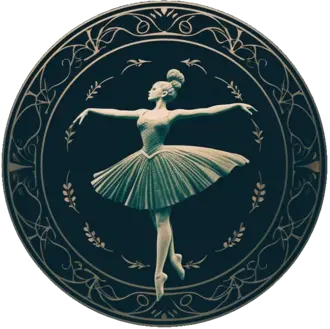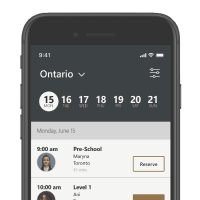18+
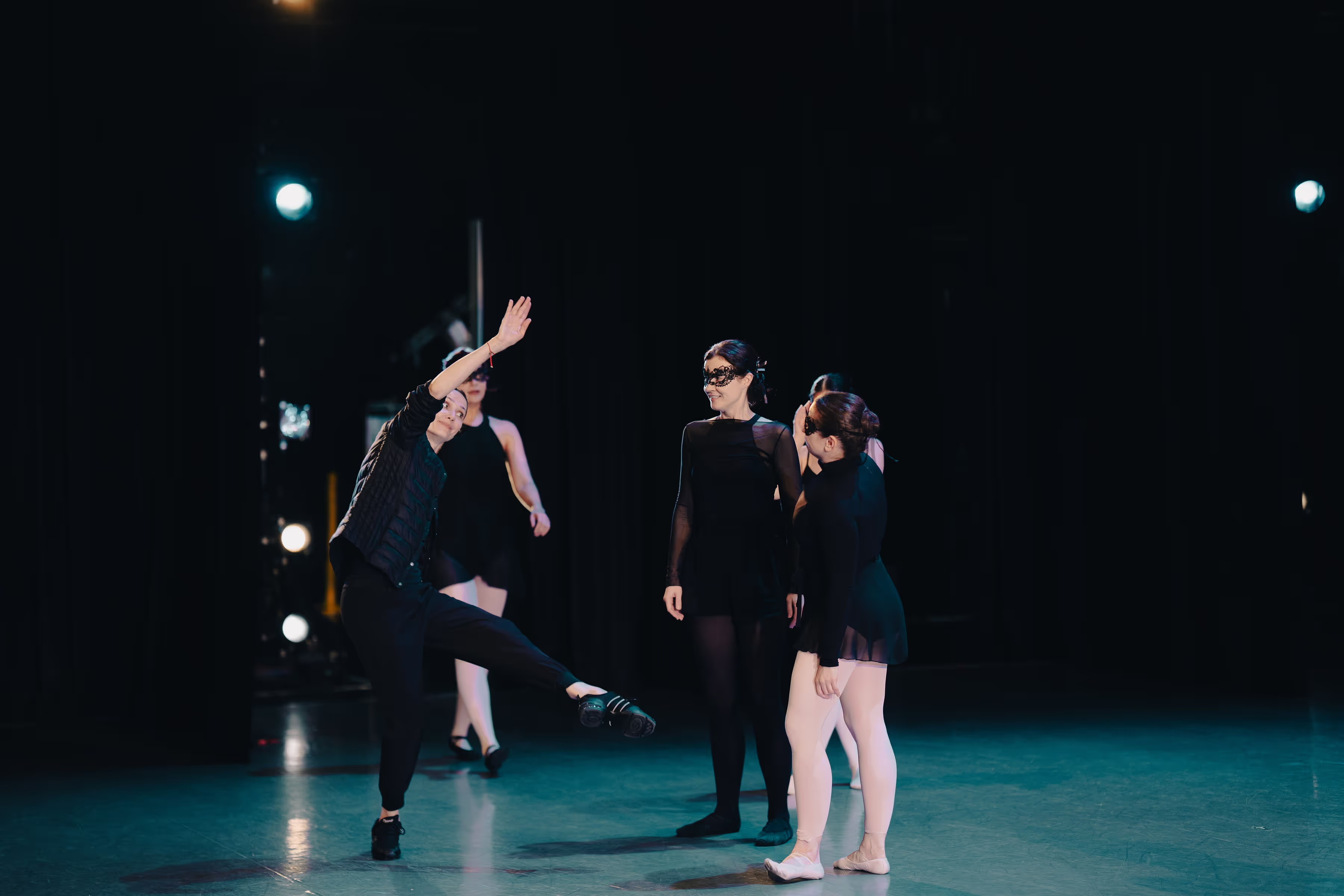

Adults
Our Adult Ballet Program is the most extensive classical ballet offering of its kind in Canada. Designed specifically for adult dancers of all levels—from absolute beginners to experienced dancers—this program invites you to step into a world of artistry, discipline, and discovery.
Through our uniquely structured membership system, you’ll gain access to weekly ballet classes tailored to your level, a wide range of open-level conditioning and cross-training classes, and the option to deepen your journey through performance opportunities, private coaching, and studio rentals for independent practice.
Whether you’re reigniting a long-lost passion or exploring ballet for the first time, our program offers a supportive, inspiring space to grow. Ballet is for everyone—and it’s never too late to begin.

Ages 18+
We’ve teamed up with Broche Ballet and the Adult International Ballet Festival in Florida to share our vision for adult dancers and the future of ballet. Tune into our chat with Julie from Broche while you browse!
Trial Options for New Students
First-timers can buy a trial class or trial package before becoming a member to try our classes. Trial packs are for first-timers only, you can only buy 1 trial pricing option one time. Creating duplicate accounts with multiple emails to buy more trial packages will result in your account being terminated and no refund provided.
Memberships
Choose the membership level that matches your ballet experience and goals. All memberships include access to complementary fitness and wellness classes.
Please Note: We do not offer discounts or rate adjustments for reduced attendance. Membership pricing is fixed to provide high quality instruction and curated class offerings year-round.
✓ Classes run year-round with no fixed term dates
✓ Enroll anytime and progress at your own pace
✓ Cancel membership anytime with 7 days notice prior to your next renewal date
✓ Freeze membership up to 2 times per year with 7 days notice prior to your next renewal date - no limit on freeze length!
Adult Ballet Intro
%201.svg)
Perfect for those new to ballet. Focus on fundamental positions, basic barre work, and ballet vocabulary.
Includes unlimited access to Ballet Intro, Ballet Stretch, Ballet Gymnastics, Ballet Barre, Mat Pilates, Ballet Body, Ballet Workout, Rehabilitative Ballet, Neoclassical Ballet, and Character Dance.
There is no limit to the amount of sessions you can attend!
No-Show Fee: $10 fee for no-show bookings
Adult Level 1
%201.svg)
Beginner level for students with basic ballet foundation. Focus on fundamental positions, basic barre work, and simple center combinations.
Includes unlimited access to Ballet Level 1, Ballet Stretch, Ballet Gymnastics, Ballet Barre, Mat Pilates, Ballet Body, Ballet Workout, Rehabilitative Ballet, Neoclassical Ballet, and Character Dance.
There is no limit to the amount of sessions you can attend!
★ Prerequisite: Must have completed 10 Ballet Intro classes or have instructor permission.
No-Show Fee: $10 fee for no-show bookings
Adult Level 2
%201.svg)
Intermediate level for students with a solid ballet foundation. More complex combinations and introduction to allegro.
Includes unlimited access to Ballet Level 2, Ballet Stretch, Ballet Gymnastics, Ballet Barre, Mat Pilates, Ballet Body, Ballet Workout, Rehabilitative Ballet, Ballet Repertoire, Neoclassical Ballet, and Character Dance.
There is no limit to the amount of sessions you can attend!
★ Prerequisite: 1-2 years of consistent recent experience who have not started pointe work.
No-Show Fee: $10 fee for no-show bookings
Adult Level 3
%201.svg)
Intermediate level with a strong a strong ballet technique and artistry. Includes pointe work for qualified students.
Includes unlimited access to Ballet Level 3, Pointe, Ballet Stretch, Ballet Gymnastics, Ballet Barre, Mat Pilates, Ballet Body, Ballet Workout, Rehabilitative Ballet, Ballet Repertoire, Neoclassical Ballet, and Character Dance.
There is no limit to the amount of sessions you can attend!
★ Prerequisite: 3-4 years of consistent recent experience.
No-Show Fee: $10 fee for no-show bookings
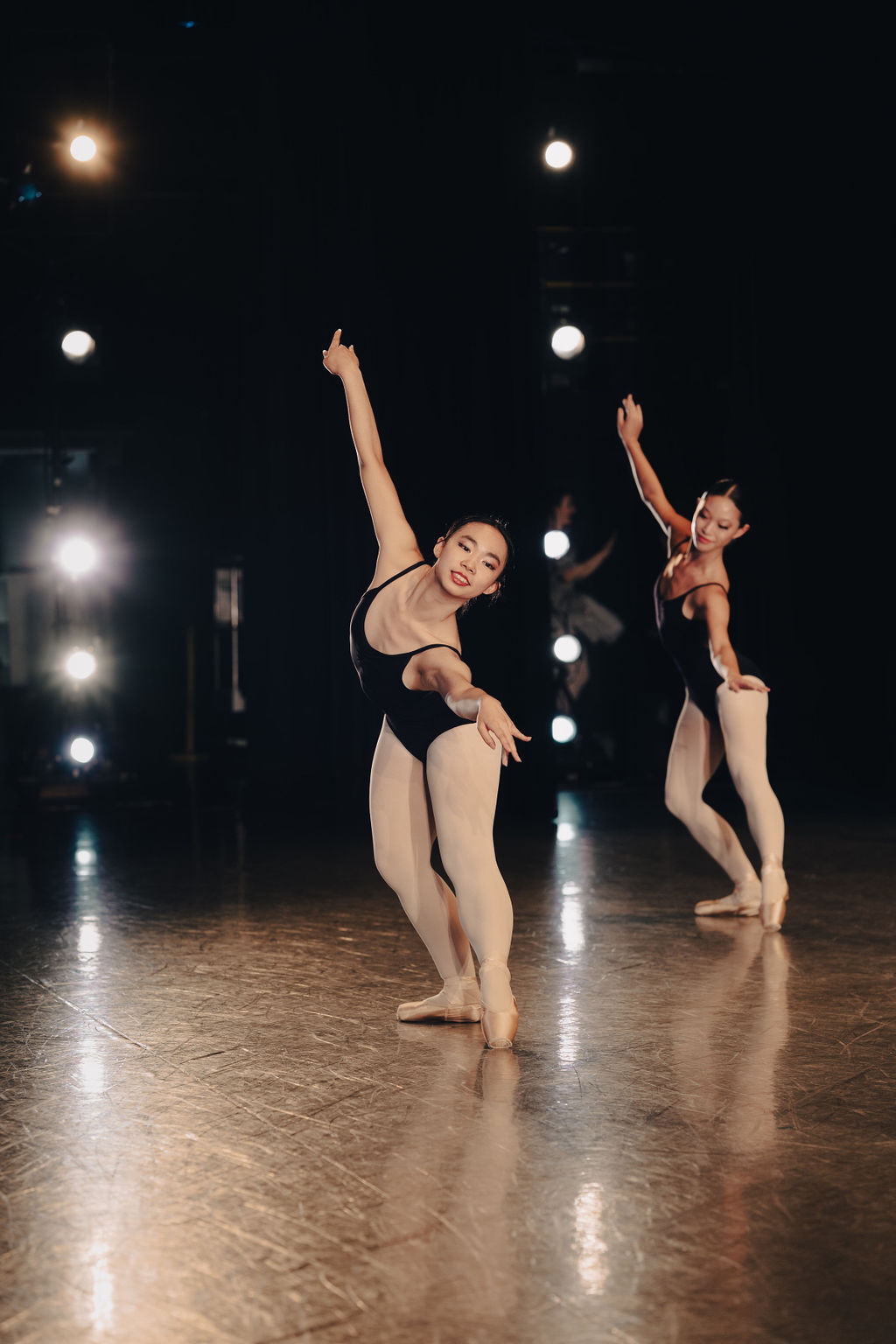
✓ Membership includes placement into one ballet level
✓ Membership includes access to all open-level classes
Classes Included In Your
Membership
Explore the comprehensive range of classes available with your membership. Each class is designed to complement your ballet training and overall fitness goals.
Ballet Level Classes
This class begins by introducing elements of parterre gymnastics, including stretches and exercises for the core and back, alongside activities designed to enhance flexibility in the feet, hips, and spine. These exercises are meticulously structured to prepare the body to handle physical demands efficiently and to learn the correct use of muscles.
At the barre, movements are carefully practiced at a slow pace, progressing from simple to more complex such as demi-plié, battement tendu, battement tendu jeté, rond de jambe par terre, battement fondu, battement frappé, relevé lent, grand battement. This section emphasizes the correct execution and muscle engagement, with students using both hands for support.
In the centre, students engage with various port de bras, poses, and fundamental movements such as plié, battement tendu, and temps lié. In the allegro section, students learn sauté, échappé in 2nd position, and changement de pied.
The class concludes with diagonal movements like marching, running on demi-pointe, and skipping. These are essential building blocks for mastering more complex dance sequences in future lessons.
This class begins by introducing elements of parterre gymnastics, including stretches and exercises for the core and back, alongside activities designed to enhance flexibility in the feet, hips, and spine. These exercises are meticulously structured to prepare the body to handle physical demands efficiently and to learn the correct use of muscles.
At the barre, movements are carefully practiced at a slow pace, progressing from simple to more complex such as demi-plié, battement tendu, battement tendu jeté, rond de jambe par terre, battement fondu, battement frappé, relevé lent, grand battement.
This section emphasizes the correct execution and muscle engagement, with students using both hands for support.
In the centre, students engage with various port de bras, poses, and fundamental movements such as plié, battement tendu, and temps lié. In the allegro section, students learn sauté, échappé in 2nd position, and changement de pied.
The class concludes with diagonal movements like marching, running on demi-pointe, and skipping. These are essential building blocks for mastering more complex dance sequences in future lessons.
This class begins by introducing elements of parterre gymnastics, including stretches and exercises for the core and back, alongside activities designed to enhance flexibility in the feet, hips, and spine. These exercises are meticulously structured to prepare the body to handle physical demands efficiently and to learn the correct use of muscles.
At the barre, movements are carefully practiced at a slow pace, progressing from simple to more complex such as demi-plié, battement tendu, battement tendu jeté, rond de jambe par terre, battement fondu, battement frappé, relevé lent, grand battement.
This section emphasizes the correct execution and muscle engagement, with students using both hands for support.
In the centre, students engage with various port de bras, poses, and fundamental movements such as plié, battement tendu, and temps lié. In the allegro section, students learn sauté, échappé in 2nd position, and changement de pied.
The class concludes with diagonal movements like marching, running on demi-pointe, and skipping. These are essential building blocks for mastering more complex dance sequences in future lessons.
This class aims to deepen students’ understanding of dance movements, broaden their technical skills, and enhance their danceability and endurance. Structured according to the Vaganova method classical ballet syllabus, this class offers a progression in learning that builds upon foundational skills in ballet, tailored to cultivate both the precision and fluidity essential for more advanced techniques.
It begins with a brief warm-up to prepare the body and muscles for the lesson. This is followed by barre exercises, where students perform movements with one hand on the barre, such as demi-plié, grand plié with port de bras, battement tendu (croisé, effacé, écarté), battement tendu jeté with piqué and balançoire, rond de jambe par terre (on floor, 45°, 90°) with port de bras open leg front and back, battement fondu (45°, 90°), rond de jambe en l’air, battement frappé, and grand battement.
At the centre, students learn movements such as temps lié, including small and large poses (in croisé, effacé, écarté), arabesque, and various adagios. In the allegro section, students learn sauté, échappé in 1st and 4th position, sissonne en 1st arabesque, and changement de pied.
Jumping is integrated to strengthen leg muscles and build endurance. Simple turns are also introduced.
The final part of the lesson involves short dance compositions, such as the polka, polonaise, and pavane. These help develop expressiveness, danceability, and acquaint students with various dance forms.
This class starts with a warm-up at the barre, where the instructor checks and explains the proper positioning and movement of the foot in pointe shoes, focusing on the correct use of the legs and body. Basic movements at the barre are gradually introduced, aimed at strengthening the leg muscles, such as: relevé in different positions, pas échappé, pas jeté pas assemblé, pas glissade, and sissonne simple. All movements are taught progressively from simple to advanced, tailored to the individual pace and abilities of each student.
As mastery increases, these movements are practiced in the centre of the room, where coordination of the legs and arms is integrated, dance elements are incorporated, and complex movements like pas de bourrée suivi, temps lié, pas couru, and pas de balancé with arms are added.
The lesson concludes with a brief stretching session for the hamstrings, calves, and ankles.
Open Level Clases
Learning classical repertoire is an essential part of ballet training because it allows students to experience the art form in its most complete and expressive form. Repertoire strengthens technique by applying turnout, alignment, and control to demanding choreography. It develops musicality and artistry, as dancers learn to interpret phrasing, rhythm, and storytelling rather than simply repeating steps. It also preserves tradition, connecting today’s students with the great works of the past and linking them to generations of dancers who have performed the same variations. Finally, it builds versatility by exposing dancers to a wide range of styles, characters, and emotions, helping them adapt to the physical and theatrical demands of performance.
At the heart of this study is the rich tradition of classical ballet rooted in the Russian heritage. These works, created by legendary choreographers and composers, represent the highest achievements of the art form and continue to inspire audiences everywhere. There is nothing in the world of dance that compares to the great Russian ballets, which have set the standard for excellence and captured hearts across generations.
In this class, students rehearse excerpts from some of the most celebrated productions in ballet history, including Swan Lake, The Nutcracker, Sleeping Beauty, Giselle, Don Quixote, etc. The focus is not only on learning the choreography but also on embodying the artistry, musicality, and character that bring these masterpieces to life.
Each class begins with a thirty-minute warm-up at the barre, followed by thirty minutes of focused variation practice. Students should expect to attend once per week and will be working on a single variation for three months at a time, allowing enough repetition and depth to understand the style and refine performance quality.
This is a challenging class designed for dancers who are ready to go beyond the basics. It is recommended for those who already have prior dance or ballet experience and a basic level of coordination that allows them to follow instruction independently. While beginners are welcome, it is important to understand that this is not a foundational technique class. Students will be expected to follow the teacher as best they can, even before the movements feel natural, using the process as motivation to grow. With steady participation, dancers will see their technique, confidence, and stage presence expand as they step into the timeless world of classical ballet.
Ballet gymnastics, also known as parterre barre or Knyazev gymnastics, was pioneered by Russian dancer and teacher Boris Knyazev, who introduced the method in 1937 at his Knyazev Paris School. Decades later, instructor V. A. Popov expanded and popularized the technique in 1975 in Russia, developing it into a structured system for improving flexibility, turnout, and joint mobility—key components of classical ballet training.
This practice complements ballet classes by helping students prepare their bodies for the demands of dance. Exercises are tailored to individual skill levels, offering encouragement and accessibility to all participants, regardless of their experience.
A typical session begins with a warm-up to prepare the body for movement. This is followed by exercises performed on the floor to enhance flexibility and strength. Additional exercises lying on the back, stomach, or sides target the core, back, and lateral muscles, improving coordination and mobility. Stretching and jumping exercises are included to increase muscle elasticity and build stamina.
Each session lasts one hour, allowing for comprehensive engagement of all necessary muscle groups. Ballet gymnastics promotes better posture, increased muscle and ligament elasticity, and stamina, making it an excellent addition to ballet training or a standalone class for those looking to improve their physical well-being.
Ballet Stretch is a full-body stretching and flexibility and mobility class developed in-house to support dancers in increasing range of motion, releasing tension, and building long-term flexibility. Designed to complement ballet and movement training, this class progresses from standing work to deep mat-based stretches, focusing on safe alignment, muscular activation, and breath.
The class begins standing, with roll-downs, side leans, and spinal articulation to mobilize the back and hips. Shoulder circles, arm rotations, neck tilts, and gentle head rolls release upper body tension. Foot articulation and ankle rolls are used to prepare the lower legs, followed by deep hip stretches like pulsing side leans, table-top forward bends, and hamstring release in folded positions.
On the mat, the class transitions into a series of grounded exercises to open the spine, hips, and legs. Movements include cat-dog, cobra, frozen frog, boat pose, hip circles, and seated folds. Signature stretches such as butterfly with forward lean, lotus curls, and pigeon variations help deepen hip flexibility. Band-assisted stretches target the hamstrings and inner thighs, progressing toward middle splits, front splits, and frog. Final seated or reclining postures are used to release remaining tension and support relaxation.
This class is suitable for all levels and can be taken regularly to improve mobility, support recovery, and increase flexibility across the full body. Whether you’re working toward a split or simply looking to move more freely, this class offers a clear, progressive structure in a calm and supportive environment.
Developed by fitness expert Leah Sarago in the early 2010s, Ballet Body blends classical ballet, yoga, and Pilates into a fluid, low-impact conditioning program. With a background in dance and exercise science, Sarago created the method to sculpt lean, elongated muscles while emphasizing posture, flexibility, and muscular control.
Each class begins with a full-body warm-up to activate the core and promote joint mobility. This is followed by upper-body mat work using bodyweight, featuring exercises such as planks, traditional and arabesque push-ups, and fluid arm movements inspired by ballet’s port de bras. Lower-body work takes place at the barre, incorporating plié squats, passé leg lifts, attitude pulses, and extended isometric holds to deeply engage the glutes, hips, and thighs. The core section on the mat includes abdominal curls, oblique twists, and plank variations such as side planks and forearm planks with leg lifts, all targeting the “six-pack” muscles and deep stabilizers for total core development.
The class concludes with a cool-down and stretch component that draws from both yoga and ballet, helping to relax worked muscles and improve flexibility. This includes forward folds for the hamstrings, hip opener stretches, and upper-body stretches drawn from ballet’s port de bras for the arms and shoulders.
Ballet Body offers a full-body toning experience—from sculpted arms and a strong core to firm, lean legs—using only minimal equipment. It is gentle on the joints thanks to its low-impact format, while still delivering an intense, sweat-inducing workout. Emphasizing proper alignment and controlled movement, the class builds not just strength, but also balance and posture. The dedicated stretching enhances flexibility and reduces the risk of injury, supporting long-term mobility and a dancer’s aesthetic.
Inspired by the original New York City Ballet Workout developed in the 1990s under Ballet Master in Chief Peter Martins and introduced in the 1997 book and DVD series, this class is based on “fifty stretches and exercises anyone can do” to achieve strength, grace, and a sculpted physique. It brings the elegance and athleticism of ballet into a structured fitness format designed for all bodies.
The class opens with flowing arm and leg movements that elevate the heart rate gently and loosen the joints and muscles in preparation for ballet movement, while also engaging the core and promoting coordination. This is followed by targeted stretching of the major muscle groups to increase flexibility and release tension—classic dancer stretches such as forward bends, hip openers, and calf/foot stretches to improve range of motion and posture.
Floor barre and core conditioning follow, using lying exercises to strengthen turnout, hip alignment, and abdominal control. These sequences target the legs and glutes with controlled movements such as leg lifts, développés, and rotations. Core work includes abdominal exercises that support balance, stability, and midsection tone.
Standing at the barre, participants practice ballet fundamentals including pliés, tendus, dégagés, passés, attitude balances, grands battements, and arabesque lifts. These exercises develop leg strength, foot articulation, balance, and posture. Center work and allegro follow—without the support of the barre, participants rely on core strength and control to execute small jumps (petit allegro), such as sautés and other springing steps that build agility and cardiovascular endurance. The final portion of class includes a short choreographed dance combination set to music, giving students the opportunity to apply movements artistically while developing memory and musicality.
The class concludes with a reverence, which serves as a cooldown and a gracious closing ritual.
This class promotes lean muscle development, core strength, posture, and flexibility. Combining technical focus with artistic movement, it offers a full-body workout rooted in the discipline and beauty of classical ballet. The structure ensures a well-rounded session that improves cardiovascular fitness, muscle tone, and mental focus while imparting the elegance of ballet. By the end of the class, one can expect not only a complete physical workout but also an experience of the art form’s beauty: building a dancer’s strength and control, alongside a dancer’s poise and confidence.
Neoclassical ballet emerged in the 1920s with Sergei Diaghilev’s Ballets Russes and took full form through George Balanchine’s visionary choreography. It retains the precise technique of classical ballet but removes elaborate narratives and heavy sets, favouring streamlined, abstract movement, asymmetrical lines, and heightened musicality. Balanchine’s early work “Apollo” (1928), set to Stravinsky’s score, showcased the genre’s defining qualities: clarity of form, dynamic rhythm, innovative partnering, and emotional subtlety. Genres evolved further through artists such as Jerome Robbins, Frederick Ashton, and Boris Eifman, ensuring this style remains central to contemporary ballet.
Each class focuses on developing a choreographed neoclassical dance. Students begin by learning short center-floor combinations that introduce the movement vocabulary, musical phrasing, and stylistic elements of the piece. These combinations are then woven together into a continuous sequence, which is rehearsed and refined throughout the lesson. Each class builds on material from the previous one, so dancers deepen their understanding and execution over time.
Newcomers should expect a learning curve, as this is a technically challenging class designed for intermediate and advanced dancers.
Modern lifestyles often involve long hours of sitting, leading to poor posture, muscle imbalances, and chronic tension in the back, neck, and hips. This rehabilitative ballet class is designed to counteract the effects of prolonged sitting and improper body alignment through gentle, structured movement. Using principles of ballet, the class helps correct postural habits, strengthen deep stabilizing muscles, and improve joint mobility in a way that is both restorative and effective. By focusing on alignment and controlled exercises, students will work to release built-up tension, retrain movement patterns, and develop strength to support long-term postural health.
The class begins with warm-up and joint mobilization (10-15 minutes) to awaken the body and encourage circulation. Seated or standing breathwork engages the deep core, while gentle exercises for the neck, shoulders, and spine promote mobility and release tension. Movements such as cat-cow stretches, seated twists, and forward folds help restore flexibility in the back, while hip openers and ankle articulation exercises support fluid, pain-free movement in the lower body.
Following this, students move into barre on the chair – posture and strength (15-20 minutes). A modified ballet barre is practiced from a seated position, focusing on spinal alignment and controlled movement. Exercises include releves, tendu brushes, frappé, and fondu, all adapted to support joint stability and muscular engagement without strain. A seated weightlifting session follows, incorporating light wrist weights (1.5-2 lbs) while moving through port de bras to gently strengthen the upper body and reinforce postural awareness.
The class progresses to standing and core work – posture correction and strength (10-15 minutes). This section targets the deep postural muscles, reinforcing proper alignment and correcting habits formed from extended periods of sitting. Balance exercises, such as simple retiré and arabesque holds, improve stability, while gentle relevés and slow développés engage the core and leg muscles. Pilates-inspired ballet exercises further support spinal elongation and controlled movement.
Next is dynamic movement – flow and coordination (10-15 minutes), where students integrate learned techniques into continuous, flowing movement. Simple ballet-inspired sequences emphasize fluidity and control, incorporating easy adagio, port de bras, and gentle traveling movements like waltz steps, balancés, and tendu walks. Stretching is incorporated within movement to elongate muscles and enhance mobility.
The session concludes with cool down and stretching (10-15 minutes) to relax the body and reinforce alignment. Deep stretches for the hamstrings, hip flexors, and spine help release any residual tension, while breathwork encourages relaxation and a renewed connection to body awareness.
Barre is a unique fitness class that blends ballet-inspired movements with strength training, offering a full-body workout rooted in both artistry and precision. Created in 1959 by German dancer Lotte Berk, who combined rehabilitative exercises with her ballet background, barre has since become a transformative method for building strength, flexibility, and core stability.
Each class begins with a warm-up to prepare the body and activate key muscle groups. Participants then transition to exercises at the ballet barre, focusing on controlled, small movements like pliés, relevés, and leg lifts to sculpt the legs, glutes, and arms. Core work follows, with floor-based movements such as abdominal curls and oblique twists to enhance stability and alignment. Props like light weights, resistance bands, and exercise balls may be incorporated to add variety and challenge. Stretching is woven throughout the session to improve flexibility and maintain balance, with a final cool-down to relax the body and support recovery.
Set to energizing music, this low-impact, high-intensity workout creates a dynamic and supportive environment suitable for all fitness levels. Whether taken as a complement to ballet training or as a standalone class, barre leaves participants feeling strong, aligned, and rejuvenated.
Rooted in the expertise of a ballet teacher, this ballet barre class blends classical technique with modern fitness for a workout that is both powerful and graceful. Similar in structure to Pure Barre®, it is distinguished by its unique foundation in ballet knowledge, bringing artistry and precision to every movement.
Mat Pilates is a floor-based exercise class designed to strengthen the core, improve flexibility, and enhance overall body awareness. Developed by Joseph Pilates in the early 20th century, this method emphasizes controlled movements, precision, and mindful breathing, using your own body weight as resistance to build strength and balance.
During class, you will engage in exercises such as leg lifts, planks, and spinal articulation to target the core, back, and limbs. These movements promote balanced muscle development, alignment, coordination and flexibility. The session also includes stretching to improve flexibility and relaxation. Breathing techniques are incorporated to deepen the practice and connect the mind and body, enhancing the overall experience.
Mat Pilates offers numerous benefits, including improved posture, increased flexibility, and enhanced body awareness. The low-impact nature of the class makes it accessible for all fitness levels, while the focus on balance and stability helps alleviate stress and tension. Whether you’re new to Pilates or refining your practice, this class provides a supportive environment to improve your physical fitness and overall well-being.
Character dance is a stylized adaptation of traditional folk and national dances within classical ballet, using modified steps and music designed for the theatrical stage. It emerged during the 19th-century Romantic era, when choreographers—spurred by a wave of Romantic nationalism—began incorporating folk dances into ballets to impart local color and cultural authenticity. These character dances became integral to ballet storytelling, serving as lively divertissements that showcased diverse national styles; famous ballets like Swan Lake and Don Quixote include celebrated character dance sequences (such as Spanish, Hungarian, or Polish dances) that enrich their narratives. Today, character dance remains an important component of ballet. It is preserved in the repertoire of classical productions and is still taught as a specialized part of ballet training, particularly within Russian and certain European ballet traditions, continuing to infuse the art form with the color of its folk dance heritage.
The class begins with movements on the floor, known as Parterre. These exercises are designed to prepare the body by targeting the core muscles, back muscles, hips, knees, legs, and feet, including the toes. Activating and strengthening these muscle groups ensures readiness for the next phase of the class.
At the barre, students will practice battement tendu, battement tendu jeté, rond de jambe par terre, battement fondu, adagio, and grand battement. These exercises develop proper footwork, arm coordination, and overall body alignment. A strong technical foundation is essential for character dance, particularly in mastering the grounded, rhythmic, and stylized movements that define the form.
In the center, students will explore introductory elements of various character dances. The class covers styles from Spanish, Russian, Hungarian, Arabic, and Italian traditions, focusing on fundamental movements, stylistic differences, and the expressive qualities that bring each dance to life. Steps and techniques will be broken down to build confidence in movement quality, musicality, and storytelling.
This class helps to build a strong foundation for character dance, providing the essential technical skills and stylistic understanding needed to begin exploring this dynamic and expressive dance form. Regular practice and continued study will further develop coordination, strength, and confidence in movement.
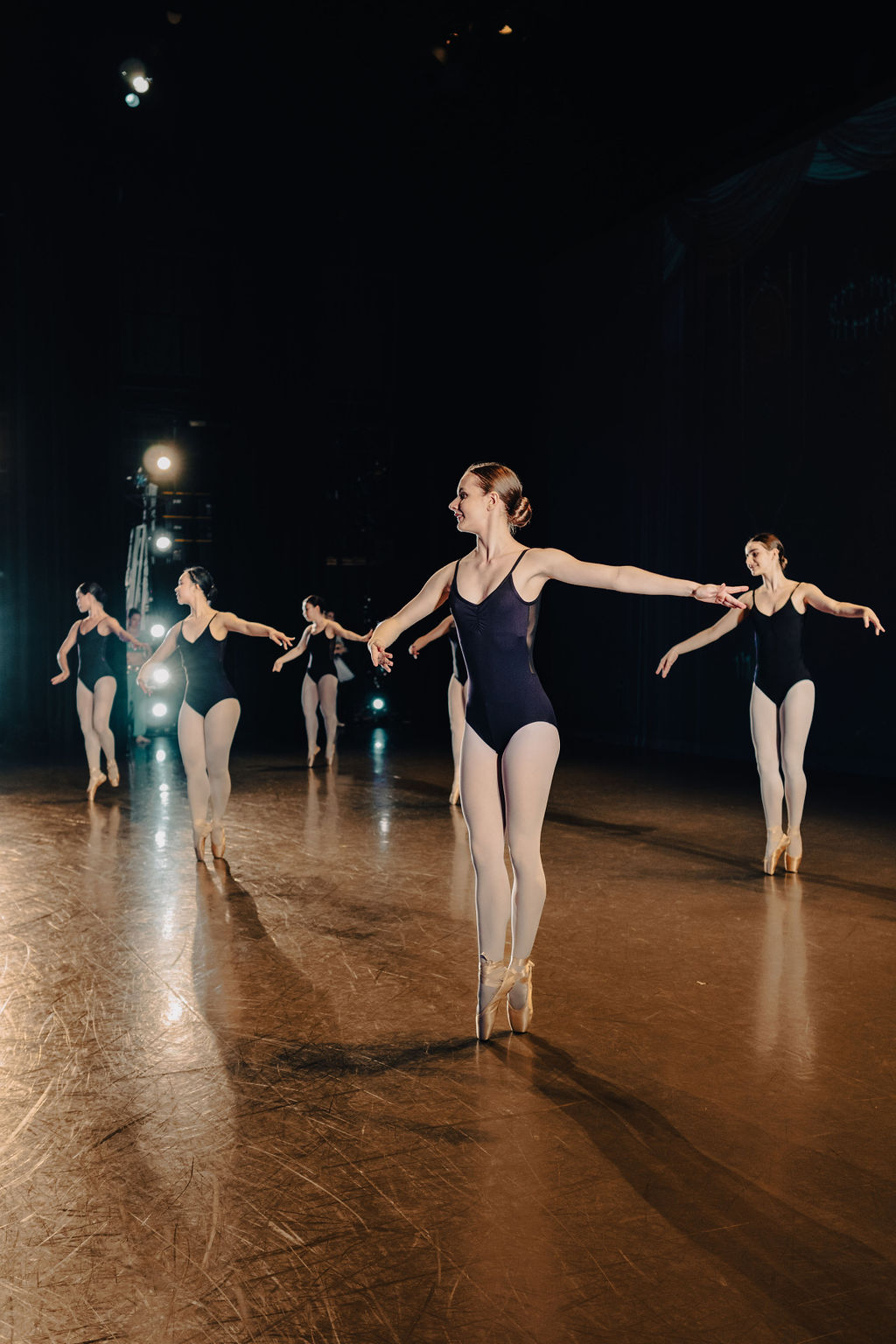
✓ Choose a time that works for you as a soloist, duet, or corps (group) to rehearsal for the academic term based on your placement
Adult Performance
Academic Year Membership Add-On
Take your ballet training to the next level with our exclusive Adult Performance program. This 10-month course culminates in a professional stage performance, where students perform alongside industry ballet professionals as part of our year-end show. Experience the artistry and discipline of ballet as a true performing art form.
- Weekly rehearsals
- One costume fee
- One performance fee
Year-End Show
Date: Mid to Late June
$100 x 43 sessions
$200 One Costume
$300 Performance Fee
Cancellation PolicyA minimum of 24 hours’ notice is required to cancel rehearsal sessions. Cancellations must be made through our website, branded app, Mindbody app, or using the chatbot on our website.
Refund PolicyThis add-on is final sale. No refunds will be granted under any circumstances including, but not limited to, non-attendance or voluntary withdrawal.
Private Training
Experience personalized ballet instruction with our world-class faculty. Private training for adults is
available year-round and can be joined at any time, offering the flexibility to work around your
schedule while receiving individualized attention.
✓ Receive personal guidance and training each week
✓ Cancel membership anytime with 3 days notice
✓ Freeze membership up to 2 times per year
Private Training Membership
Please note: We do not allow one-offs after the first consultation or to create à la carte packages for private trainings.
If you wish to have a consultation have a consultation with multiple teachers before deciding, please contact our office.
Private training sessions are available year-round with flexible scheduling options. Book your preferred time slots and work with our expert instructors.
No-Show Fee: Loss of session + $10 fee for no-show private training appointments
Rehearsal Rooms
Book our professional rehearsal spaces for private practice or group rehearsals. Both studios feature
Marley dance floors, full-length mirrors, portable ballet barres, HVAC climate controls, and sound
systems to support your artistic development.
★ Rehearsal room booking is only available to dancers with active memberships at the school.
★ No outdoor shoes, tap shoes, or heels are permitted in rehearsal rooms to prevent damage to the floors.
★ Please ensure the air conditioning, lights, and sound system are turned off at the end of your booking.
Studio A
Uniform
Proper attire helps create a focused learning environment and allows instructors to observe and
correct technique effectively.
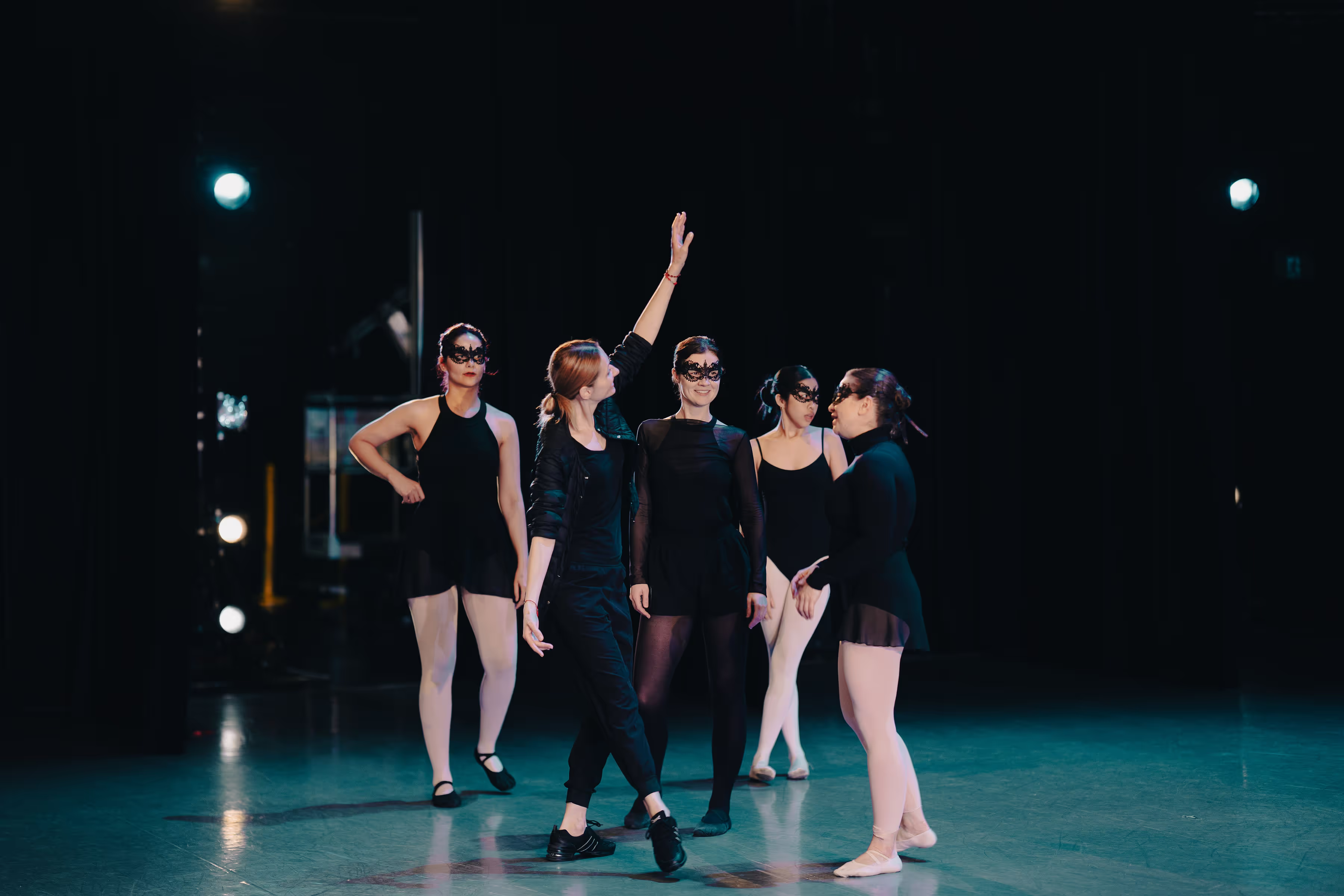
Women’s Uniform
Choice of leotard, optional skirt, tights matching your skin color, hair secured in a bun. Canvas ballet shoes matching your skin colour. No jewelry except small earrings.
★ Available in various sizes
Men’s Uniform
Plain form-fitting t-shirt (no logos or graphics), grey or black leggings, white socks. Black leather or canvas ballet shoes matching your skin colour. Hair should be neat and out of face.
★ Professional dancewear required
Gender-Inclusive Uniform
Student’s choice of women’s, men’s, or combination of both styles–based on comfort and expression.
★ Please Note: The above are recommendations, not requirements. Adults may choose their own colours or styles for their uniform.
Dancewear is not required for trial classes or intro packages.
Ballet shoe and pointe fittings are available at our partner store.
Uniform Store Information



Visit our partner store for fitted uniform consultation and professional dance wear.

